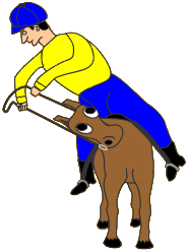Turning Horses

Most people try too hard when attempting to turn a horse. You should not lean into the turn as if you were trying to turn a bicycle. Nor should you pull the reins either back — the horse might break his gait or even stop — or too far to the side.
Leaning will throw the horse off balance and probably confuse him. If you pull the reins too far — say to the right — you will end up turning your horse's nose in the other direction. You can imagine how that might confuse him.
The simplest way to get a turn to the right is to bring your left leg back about one or two inches, keeping your heel down. Then, rotate your upper body — from the hips up — to the right. Let your hand — or hands — move with your body. Let your head, also, move with your body. Your eyes should determine how sharply you turn.
Look at a point approximately one–sixth of the circumference ahead on an imaginary circle painted on the ground. On a larger circle, your body will not turn as much as on a smaller circle. Some people say you should always look between the horse's ears. If the horse is bent correctly around your inside leg, this would probably be about right.
If you rotate your body at the hips, the horse will feel a number of different things. The weight of your inside seat bone will increase slightly, and the inside of your outside thigh will put a slight pressure against the side of the horse. Don't consciously apply either of these; just let them happen. As your arms and hands move with your body, the outside rein will touch the side of your horse's neck — neck reining.
In most cases, this simple maneuver should bring about the turn. If it does not, you might try rubbing the outside rein slightly on your horse's neck to re–enforce the feeling. You can, also, slightly increase the pressure of your outside calf behind the girth. Without leaning, you may also apply a little extra pressure to the inside stirrup by keeping the your heal down and flexing your ankle. As a last resort, use a little pressure on the inside rein by pivoting your lower arm outward from your elbow. If you apply pressure with one rein you should release an equal amount of pressure with the other rein. Be sure to release any pressure caused by the inside rein as soon as your horse turns his head the least amount. Use the rein to indicate your intent to the horse. Don't try to drag him around the turn.
The more you practice this technique, the better reaction you should get from your horse. Eventually, it will seem that the horse is simply going where you look. Actually, you will be giving almost imperceptible cues as you look where you want to be.
Perhaps I should point out that, when cantering, the horse's hip — and therefore the rider's hip — on the lead side is further forward in relation to the horse's center line than the hip on the other side. This does not negate the idea of the rider rotating his upper body in the direction of the turn. The rider's hips and shoulders will not, however, be aligned as closely. Even in the walk and trot, the rider's shoulders and hips are not perfectly aligned when turning, but I hesitate to mention this since most riders tend to turn their shoulders too much anyway. If I tell the rider to rotate at the hips, the rider tends not to turn the shoulders as severely.